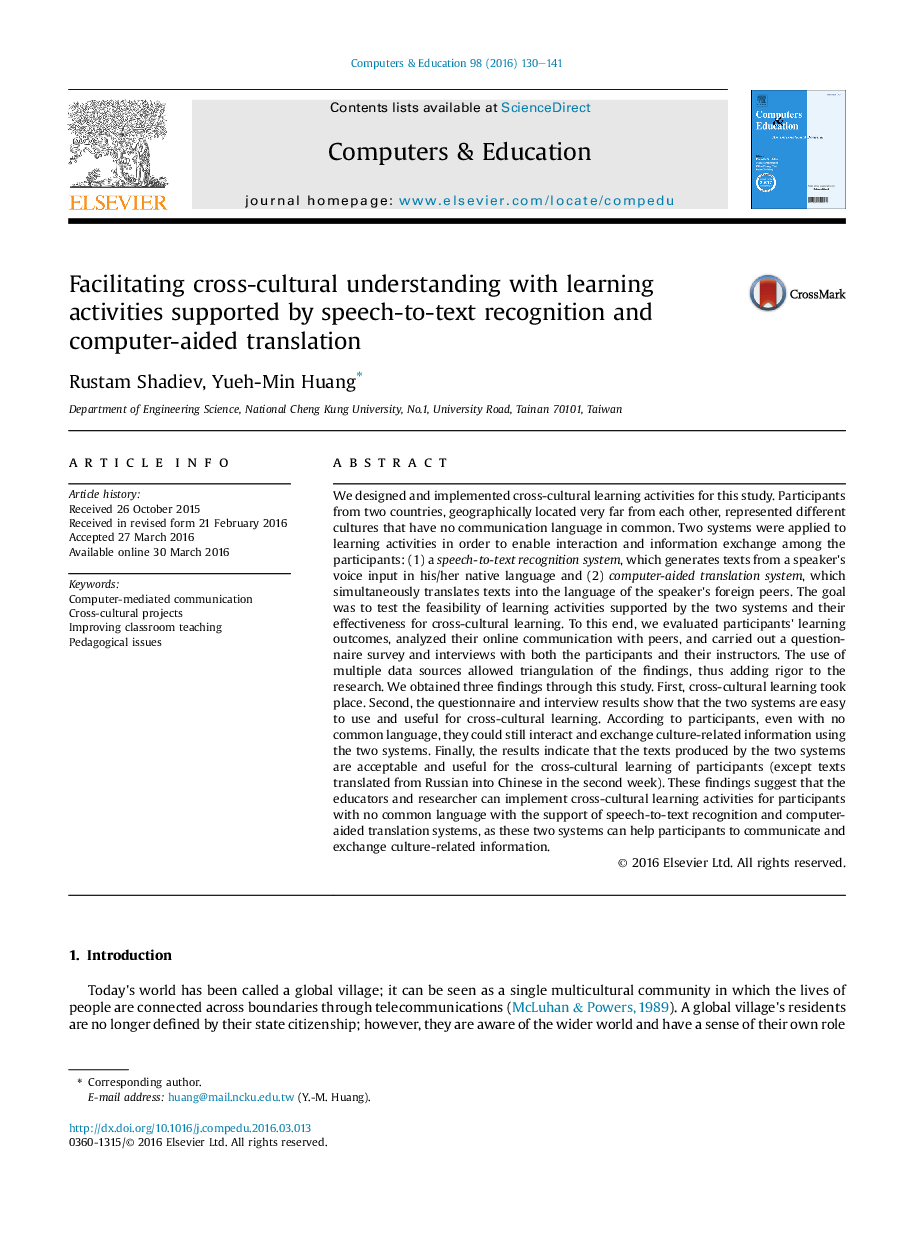| کد مقاله | کد نشریه | سال انتشار | مقاله انگلیسی | نسخه تمام متن |
|---|---|---|---|---|
| 6834878 | 618161 | 2016 | 12 صفحه PDF | دانلود رایگان |
عنوان انگلیسی مقاله ISI
Facilitating cross-cultural understanding with learning activities supported by speech-to-text recognition and computer-aided translation
ترجمه فارسی عنوان
تسهیل درک متقابل فرهنگی با فعالیت های یادگیری به وسیلۀ به رسمیت شناختن گفتار به متن و ترجمه ی کامپیوتری پشتیبانی می شود
دانلود مقاله + سفارش ترجمه
دانلود مقاله ISI انگلیسی
رایگان برای ایرانیان
کلمات کلیدی
ارتباطات با واسطه کامپیوتر، پروژه های متقابل فرهنگی بهبود آموزش در کلاس درس، مسائل آموزشی
ترجمه چکیده
ما برای این مطالعه، فعالیت های یادگیری متقابل فرهنگی را طراحی و اجرا کردیم. شرکت کنندگان از دو کشور که از لحاظ جغرافیایی خیلی دور از هم هستند، فرهنگ های مختلفی را نشان می دهند که هیچ زبان ارتباطی مشترک را ندارند. دو سیستم برای فعالیت های یادگیری به منظور فعال سازی تعامل و تبادل اطلاعات بین شرکت کنندگان اعمال شد: (1) یک سیستم تشخیص گفتار به متن، که متون را از ورودی صوتی سخنران در زبان مادری خود تولید می کند و (2) کامپیوتر سیستم ترجمه، که به طور همزمان متون را به زبان همسالان خارجی سخنران ترجمه می کند. هدف این بود که امکان سنجی فعالیت های یادگیری تحت حمایت دو سیستم و اثربخشی آنها برای یادگیری متقابل فرهنگی را تست کنند. برای این منظور، ما نتایج یادگیری شرکت کنندگان را ارزیابی کردیم، ارتباطات آنلاین خود را با همسالان مورد تجزیه و تحلیل قرار دادیم، و بررسی پرسشنامه و مصاحبه با هم شرکت کنندگان و مدرسان آنها را انجام دادیم. استفاده از منابع داده های چندگانه، امکان ترحم کشیدن یافته ها را فراهم کرد، و به این ترتیب، سختگیرانه به تحقیق افزوده شد. ما از طریق این مطالعه سه یافته را به دست آوردیم. اول، یادگیری متقابل فرهنگی صورت گرفت. دوم، پرسشنامه و نتایج مصاحبه نشان می دهد که این دو سیستم برای استفاده از یادگیری متقابل فرهنگی آسان هستند و مفید هستند. با توجه به شرکت کنندگان، حتی بدون زبان مشترک، آنها هنوز هم می توانند اطلاعات مربوط به فرهنگ را با استفاده از دو سیستم تعامل و تبادل کنند. در نهایت، نتایج نشان می دهد که متون تولید شده توسط دو سیستم قابل قبول و مفید برای یادگیری متقابل فرهنگی شرکت کنندگان (به جز متون ترجمه شده از روسیه به چینی در هفته دوم). این یافته ها نشان می دهد که مربیان و محققان می توانند فعالیت های یادگیری متقابل فرهنگی را برای شرکت کنندگان بدون زبان معمولی با حمایت از پذیرش گفتار به متن و سیستم های ترجمه ی کامپیوتری اجرا کنند، چرا که این دو سیستم می توانند به شرکت کنندگان کمک کنند تا فرهنگ را تبادل کنند -اطلاعات مربوطه.
موضوعات مرتبط
علوم انسانی و اجتماعی
علوم اجتماعی
آموزش
چکیده انگلیسی
We designed and implemented cross-cultural learning activities for this study. Participants from two countries, geographically located very far from each other, represented different cultures that have no communication language in common. Two systems were applied to learning activities in order to enable interaction and information exchange among the participants: (1) a speech-to-text recognition system, which generates texts from a speaker's voice input in his/her native language and (2) computer-aided translation system, which simultaneously translates texts into the language of the speaker's foreign peers. The goal was to test the feasibility of learning activities supported by the two systems and their effectiveness for cross-cultural learning. To this end, we evaluated participants' learning outcomes, analyzed their online communication with peers, and carried out a questionnaire survey and interviews with both the participants and their instructors. The use of multiple data sources allowed triangulation of the findings, thus adding rigor to the research. We obtained three findings through this study. First, cross-cultural learning took place. Second, the questionnaire and interview results show that the two systems are easy to use and useful for cross-cultural learning. According to participants, even with no common language, they could still interact and exchange culture-related information using the two systems. Finally, the results indicate that the texts produced by the two systems are acceptable and useful for the cross-cultural learning of participants (except texts translated from Russian into Chinese in the second week). These findings suggest that the educators and researcher can implement cross-cultural learning activities for participants with no common language with the support of speech-to-text recognition and computer-aided translation systems, as these two systems can help participants to communicate and exchange culture-related information.
ناشر
Database: Elsevier - ScienceDirect (ساینس دایرکت)
Journal: Computers & Education - Volume 98, July 2016, Pages 130-141
Journal: Computers & Education - Volume 98, July 2016, Pages 130-141
نویسندگان
Rustam Shadiev, Yueh-Min Huang,
